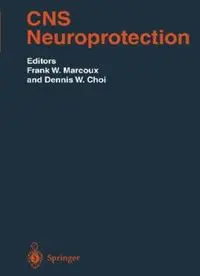
CNS Neuroprotection PDF
Preview CNS Neuroprotection
Handbook of Experimental Pharmacology Volume 155 Editorial Board G.Y.R. Born, London M. Eichelbaum, Stuttgart D. Ganten, Berlin H. Herken, Berlin F. Hofmann, Munchen L. Limbird, Nashville, TN W. Rosenthal, Berlin G. Rubanyi, Richmond, CA K. Starke, Freiburg i. Br. Springer-Verlag Berlin Heidelberg GmbH eNS N europrotection Contributors M.E Beal, K.I Becker,A. Blesch, D.W. Choi, T.M. Dawson, Y.L. Dawson, H.I Federoff, G.Z. Feuerstein,A.C. Foster, S. Gandy, M.P. Goldberg, 1M. Hallenbeck, M.W. Halterman, M. Jackson, G.A. Kerchner,A.H. Kim, W. Koroshetz, M.P. Mattson, L.P. Miller, IW. Phillis, R.M. Poole, H.D. Rosas, ID. Rothstein, M. Sasaki, c.P. Taylor, M.H. Tuszynski, K.K.W. Wang, X. Wang, IB. Wiesner Editors Frank W. Marcoux and Dennis W. Choi Springer Dr. FRANK W. MARCOUX Vice President, Biology, Pfizer Global Research and Development Ann Arbor Laboratories 2800 Plymouth Road Ann Arbor, MI 48105 USA e-mail: Preface "CNS neuroprotection" was a common subject of papers, symposia, and reviews during the previous "decade of the brain." Indeed, in recent years, experimental study of putative neuroprotective agents prompted clinical trials of numerous drug candidates in acute and chronic human neurodegenerative conditions. While the outcomes of these trials have not been as successful as initially hoped, these were early explorations, and the pipeline of relevant ideas continues to grow in strength and depth. We predict that early in this new millennium, crippling disorders such as stroke and Alzheimer's disease will be treated effectively by therapeutic neuroprotective strategies. This volume of the Handbook of Experimental Pharmacology titled eNS Neuroprotection provides a pharmacological perspective on currently promis- ing neuroprotective approaches, and a clinical perspective on the challenges involved in establishing the efficacy of these approaches through appropriate clinical trials. Section I, "Mechanistic Approaches to CNS Neuroprotection," reviews major injury mechanisms that have formed the basis for many past and present clinical trials conducted around the world. Dr. KIM and colleagues, Washington University School of Medicine, review the status of blocking excitotoxicity as an approach to CNS neuroprotection. Dr. WANG, Pfizer Global Research and Development,Ann Arbor Laboratories, outlines evidence supporting a contri- bution of apoptosis to pathological neuronal or glial cell loss. Drs. BECKER and HALLENBECK, University of Washington and the National Institute on Neuro- logical Diseases and Stroke, respectively, argue that inhibiting inflammatory pathways in the brain can be neuroprotective. Dr. BEAL, Cornell University, reviews mitochondria-directed approaches to neuroprotection. Dr. MATISON, National Institute on Aging, summarizes the current understanding of how disturbances in calcium homeostasis and intracellular signaling pathways par- ticipate in neurodegeneration; Dr. SASAKI and colleagues, lohns Hopkins Uni- versity, discuss the neuroprotective effects cif inhibiting nitric oxide toxicity. Taken together, the chapters in Sect. I provide expert commentary on well- studied mechanistic approaches to CNS neuroprotection. Section II, "Neuroprotective Agents," reviews specific pharmacological strategies for CNS neuroprotection. Dr. FOSTER and colleagues, Neurocrine VI Preface Biosciences, review adenosine-related approaches to neuroprotection. Dr. TAYLOR, Pfizer Global Research and Development, Ann Arbor Laboratories, argues that sodium and calcium ion channels are targets for neuroprotective drugs. Dr. PHILLIS, Wayne State University, reviews the status of free radical scavengers and other antioxidants as neuroprotective agents; and Drs. FEUERSTEIN and WANG, DuPont Pharmaceuticals, discuss ways of manipulat- ing chemokines and chemokine receptors to reduce neurodegeneration. The chapters in Sect. II cover specific molecular targets for neuroprotection and provide examples of pharmacological agents of current interest. Section III, "CNS Delivery of Neuroprotective Therapies," highlights gene-based neuroprotection strategies. Drs. BLESCH and TUSZYNSKI, Univer- sity of California at San Diego, review ex vivo approaches to delivering new genes to the CNS. Drs. HALTERMAN and FEDEROFF, University of Rochester, discuss viral vector-based neuroprotective approaches. Section IV, "Disease Targeting of Neuroprotective Therapies," presents clinical perspectives on bringing neuroprotective approaches to bear upon specific neurological disorders. Dr. GOLDBERG, Washington University, sum- marizes some of the progress and challenges in developing neuroprotective drugs to treat stroke. Dr. POOLE, Pfizer Global Research and Development, Ann Arbor Laboratories, discusses approaches to neuroprotective therapy in the traumatically injured CNS. Dr. GANDY, New York University, discusses using neuroprotective approaches to treat patients with Alzheimer's disease; Drs. JACKSON and ROTHSTEIN, Johns Hopkins University, do the same for patients with amyotrophic lateral sclerosis; while Drs. ROSAS and KOROSHETZ, Massachusetts General Hospital, focus on patients with Huntington's disease. Taken together, these chapters yield insights into present and future opportu- nities for neuroprotective therapies in specific neurodegenerative conditions. eNS Neuroprotection provides a pharmacological view of neuroprotective therapies. It is not intended to be exhaustive, but rather highlights major mechanistic targets and therapeutic approaches, as well as related challenges and opportunities in the clinic. The editors wish to thank all of the authors for their excellent contributions to this volume and, moreover, to this rapidly developing area of pharmacological research. FRANK W. MARCOUX DENNIS W. CHOI List of Contributors BEAL, M.E, Department of Neurology, Cornell University Medical College, 525 East 68th Street, New York, NY 10021, USA e-mail: VIII List of Contributors FOSTER, A.C., Neurocrine Biosciences Inc., Department of Neuroscience, 10555 Science Center Drive, San Diego, CA 92121, USA e-mail: List of Contributors IX PHILLIS, IW., Department of Physiology, Wayne State University School of Medicine, 540 E. Canfield, Detroit, MI 48201, USA e-mail:
